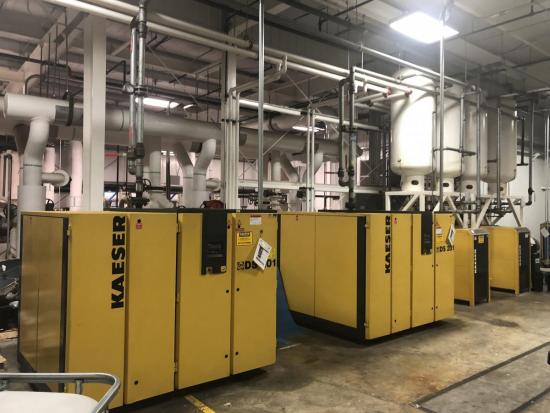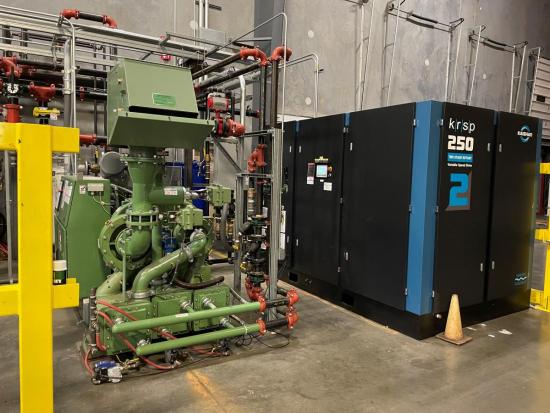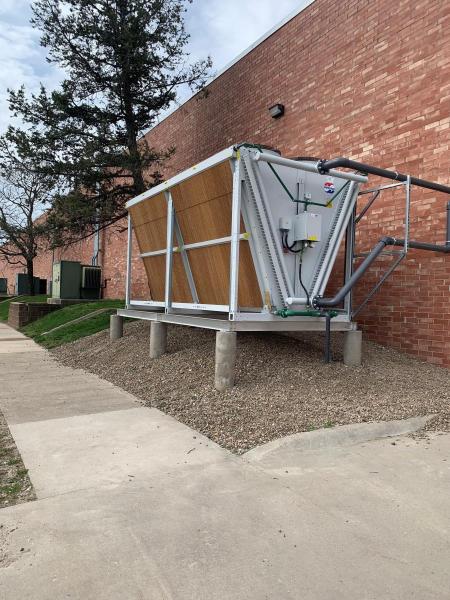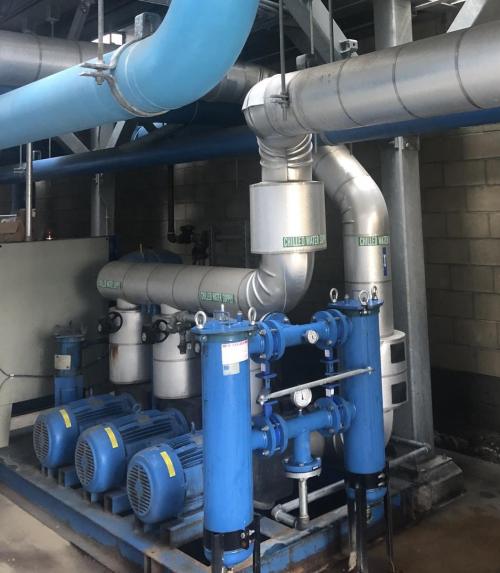07/19/2021
Berry Global was established in 1967 as a small hometown company, based in Evansville, Indiana. Today it is still headquartered in Evansville but has grown to 48,000+ global employees and more than 295 locations. Generating $12.6 billion in 2019 pro forma net sales, Berry Global creates innovative packaging and protection solutions.

Berry Global is a company which has grown through many acquisitions and now operate around 120 manufacturing sites in the U.S. Berry Global has over fifteen unique different plastic production processes. The processes will vary from plant-to-plant and, to name a few, include injection molding, blow molding, cast film, and blown film.
In February 2021, Chiller & Cooling and Compressed Air Best Practices Magazines interviewed members of the Berry Global Corporate Plant Engineering Team to gain an understanding of the work being done to improve system reliability and energy efficiency. The team members interviewed were Chris Tedford (Director of Corporate Plant Engineering), Daniel K. Pemberton (Corporate Project Engineer), and Tyler W. Lyons (Corporate Plant Engineering Manager).
Chris, what is the mission of the corporate engineering team at Berry Global?
We’ve had a Corporate Plant Engineering team for some time now and our primary objective is to help improve the reliability and efficiency of our manufacturing plant infrastructure and plant utilities. This means we cover a lot of ground including chilled water (cooling) systems, water treatment, compressed air, resin conveying systems, lighting, and electrical system safety and reliability. In our organization, some projects are plant led, where others require a very hands on approach with lots of onsite project management and some projects where we mainly help with the initial scoping and justification to get it ready for capital approval.
The team is working to develop subject matter experts in key areas. Daniel Pemberton focuses on compressed air systems and Tyler Lyons focuses on chillers, cooling towers, and cooling systems in general.
Having grown by acquisition, we are well accustomed to the discovery process of bringing a new facility into our organization. Over time our plants have taken different approaches on how to expand their infrastructure systems to meet the needs of plant expansions. Many of the plants have added equipment to meet the needs of production, which has led to poorly optimized systems. Trying to drive consistency across our plants is a challenge we have taken on. Our team has done a great job of creating a centralized inventory of assets and using that to identify, prioritize, develop, and ultimately execute on these opportunities.

An air compressor room with single-stage rotary screw air compressors and refrigerated compressed air dryers.
Daniel, Can you describe the work being done with compressed air systems?
Compressed air is a relatively new initiative, at the corporate level. The plants obviously have been managing compressed air for a long time.
Since Berry Global is the product of so many acquisitions that had different equipment preferences, maintenance schedules and practices, and capital reinvestment strategies; the first step has been to create an inventory of all compressed air system assets. For each entry in this database we track basic nameplate information, age, and how well it’s been maintained. We enter every single asset into our inventory. This generates a risk score for each asset and then an overall risk score for the system as it relates to reliability and energy. We are evaluating whether or not the system or any component, within the system, could have any impact on production in terms of downtime hours or making scrap product. The intent is also to identify some of the older and less efficient pieces of equipment. Through this study, we have learned that our average system size is in the 100 to 500 hp range at most plants.
Are compressed air system assessments and leak audits conducted regularly?
Absolutely. We have had supply-side compressed air audits performed, within the last three years at around forty percent of our plants. For the most part, audit results will remain quite accurate for us over a three-year period. We have done fewer demand-side audits, but we do perform leak studies frequently. Roughly one third of the plants do annual compressed air leak studies (and repair) while another one third has done one within the last 3 years. With the final one third of plants, they have either not done one or it hasn’t been documented.
We believe there is a 5-15% leak rate opportunity at most sites. We estimate that plants who are not conducting annual leak studies have even larger opportunities. Ultrasonic leak detectors are the identification and verification tools we use to find leaks and verify that they are fixed. We work with a couple companies for most of our leak studies, but we also use local (to each plant) compressed air distributors.
Our leak study approach varies because some plants doing them get an energy rebate from a local utility which has a formal verification process to qualify for the rebate. Every rebate process is different. On studies not tied to a rebate, typically the goal is to have them all fixed within a one to three month time period. For example, we had one plant realize a reduced leak rate from 1,200 to 300 cfm!

An air compressor room with centrifugal and two-stage rotary screw air compressors.
Besides leaks, what are some of the common compressed air optimization projects?
The opportunity for optimization is different at all of our plants. Generally, we are looking for a ten to fifteen percent energy savings from most of the projects we identify and execute. What type of compressed air project depends upon each situation. Here are a few recent examples.
- Using an existing waste stream to drive an air compressor. We are currently considering using steam and putting in a turbine to drive a centrifugal air compressor.
- Recognize part-load situations and install master controls at plants or install single trim variable speed or variable displacement rotary screw air compressor. The unload energy is what we are working to eliminate with these types of projects.
- We have a handful of plants which do require much higher installed horsepower to keep the plant running. For these large, complex systems, control optimization is the focus. In 2020, we put a compressed air management system into one of our largest U.S. plants. It’s a unique plant which has two buildings connected with a piping header, making control of 14,000 cfm of compressed air very difficult. The production lines at this facility use much more air than the average, causing 2,000 cfm swings in demand when they kick on! The result of the project was exciting as we were able to completely shut-off 800 horsepower of air compressors - really helping us with our annual energy efficiency goal!

An air compressor room with water-cooled centrifugal and variable-speed rotary screw air compressors.
Do you provide the plants with any compressed air training or education?
Do you mean aside from reading your magazine!? Yes, our corporate energy team has been driving an initiative to sponsor Compressed Air Challenge training for maintenance and technical managers in our plants. We’ve had about sixty participants and think it is excellent training. I (Daniel Pemberton) have completed both Level 1 and Level 2 training. We want to continue doing this and know it has helped develop many projects, some of those just mentioned came from a Compressed Air Challenge attendee.
Our Director Continuous Improvement, Energy, Sustainability sends out a daily email to technical contacts with a success story or highlighting Best Practices. Our team also publishes a monthly metrics, which scorecard some of these metrics at the sites and highlights successes. These are great opportunities for feedback and conversation starters around energy reduction.
Thank you Daniel.
Tyler, can you talk about your work with chillers and cooling systems? Cooling is critical to injection molding isn’t it?
You bet, our simplified business model is to melt plastic and cool it back into the form we want – and cooling water makes this happen. We need to optimize chilled water temperature and flow to ensure that our production machines make consistent finished products. In molding application, we cool the plastic through conduction and convection directly. Blown film is different in that cooling-water cools the air and then an air handler cools the plastic.
My (Tyler Lyons) primary focus has been on cooling water systems. Our number one priority is to improve the reliability and consistency of the manufacturing of our products, so we look at how chillers and water treatment can affect that. Again, we started with creating an inventory and knowledge of the assets in our portfolio. We currently operate an inventory over 600 chillers in North America. Most are in the 100 to 400 ton range.
Our first measure of reliability is chiller age. We have 67 chillers built pre 1995, which is beyond typical ASHRAE recommendations. We are becoming more proactive by looking at whether we have redundancy in the system, and working towards a short and long-term plan if we do not. If the units are air-cooled, or there are other inefficiencies, we know there might be an opportunity to save energy so we are also measuring the current energy efficiency to make a baseline.

An adiabatic chiller helped saved 10 million gallons of water annually at a Berry Global plant.
Can you describe some of the work being done with cooling water systems?
Sure thing. Our 2021 goal is to identify 10,000,000 kWh of energy savings from the cooling systems related to our chilled water systems. Understanding the applications in our plants has really helped us to optimize current systems and help us improve both reliability and efficiency. Here is a listing of projects and areas we are looking at.
- For the blown film loop, since we’re already pulling in outside air, we automatically gain the benefit of free cooling on that system. The new system design utilizes four screw compressor water-cooled chillers.
- Obviously, this works in plants with a conducive outdoor climate and also where we may already have control systems in place.
- We take Berry’s “Always Advancing” into our approach for identifying and executing O&M opportunities to maximize equipment lifetime and improve energy efficiency. We are teaching sites how to evaluate their systems and realize quick wins. Our teams are adding water filtration, adding air filters to air cooled equipment, cleaning condenser coils, adding corrosion inhibitors and biocides, and matching temperature setpoints to process requirements.
- Vendors often provide efficiency numbers at lower cooling tower temperatures. To achieve this, we use improved fan control methods that rely on the outside wet bulb temperatures.
- We did a great water savings project, in Iowa, where we will save 10 million gallons annually. The project eliminates single-pass cooling and replaces it with an adiabatic cooler. We selected an adiabatic cooler instead of a dry cooler because it will spray water on the cooling fins, creating some evaporation to lower the supply temperature beyond that of an equivalent dry cooler. This was kind of a one-off project because we do not have many single-pass cooling applications; most have been eliminated from our processes.

A pump skid for a chilled water system.
Do you have energy dashboards at the plants?
Some of our sites have energy dashboards but most sites are still going back to the utility room to check gauges or localized PLC control systems. Systems used varies widely when we look at process cooling automation. In compressed air systems, we have some master controls but most systems do not. We don’t mandate or require dashboards. We do see this happening, long term, for all plant utilities.
Does Berry Global have energy efficiency targets and goals?
Yes, these targets fall under our formal Sustainability strategy named Impact 2025 (visit https://www.berryglobal.com/sustainability/environment ). Impact 2025 strategies identify three key areas to focus on and energy efficiency falls under the 3rd area – minimizing our operational impacts.
- Optimizing the Design and Sustainable Sourcing of our Products
- Engaging Partners to End Plastic Waste and Limit Global Warming
- Minimize our Operational Impacts (normalized for production) in three areas:
- Climate Change: reduce greenhouse gas emissions 25% by 2025 vs. the Company’s 2016 baseline
- Continuous Improvement: reduce landfill waste 5% per year and reduce energy and water consumption by 1% per year
- Operation Clean Sweep©: prevents resin loss and implement this at acquisition sites within the first year
As you can see, our goal is to reduce water and energy intensity (energy and water consumed per pound processed) by 1% per year as part of our continuous improvement efforts.
Is the Company meeting the Impact 2025 energy and water intensity goals?
Although Impact 2025 provides near-term energy and water reduction goals, we have a long-term vision to be "Best in Class" in energy and water efficiency as part of our efforts to achieve Operational Excellence. Between 2018 and 2019, we reduced our energy intensity from 1.76 MWh per Metric Ton produced to 1.64 MWh/Ton. In 2020, our energy intensity initiative was negatively impacted by COVID-19 and our ongoing light-weighting efforts. Our energy intensity for 2020 was 1.65 MWh/Ton. Despite the headwinds in 2020, we are prioritizing energy reduction and expect to resume our previous trend of improvement moving into the future.
As a corporate engineering team, a large initiative of ours is to identify, prioritize and support the projects which will save 100 million kWh’s annually - including O&M (Operations & Maintenance) projects. There are four (4) operational divisions and each has their own energy and water efficiency target. One of our most exciting multi-divisional initiatives, for example, has been DC to AC conversions with VFD on extruder motors.
Thank you for sharing the way Berry Global is making an “Impact”!
For more information about Berry Global visit https://www.berryglobal.com.
To read similar Plastics Industry articles visit https://airbestpractices.com/industries/plastics or https://coolingbestpractices.com/industries/plastics-and-rubber.

